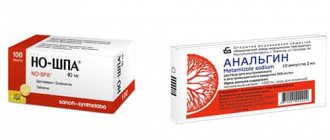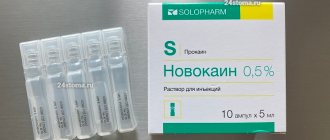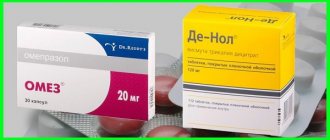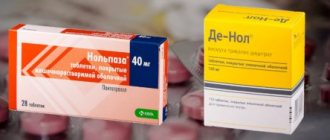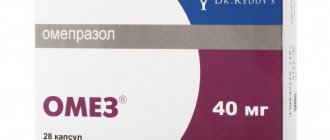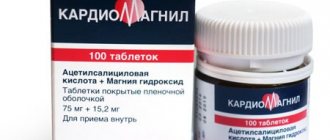Gastritis and stomach ulcers are the most common diseases of the digestive system. There are several reasons for their occurrence, but the main one is the imbalance between the aggressive acidic environment of the gastric juice and the protective mechanism of its mucous membrane.
Digestive juice contains hydrochloric acid and the enzyme pepsin. Both components play an important role in the digestion process. It is under their influence that food breaks down into its constituent organic compounds. But the lining of the stomach is also affected.
How can you help the body protect the walls of the stomach from the destructive effects of digestive juices? For this purpose, there are a number of drugs that can reduce their aggressive effects. Such medications include De-Nol and Omeprazole. Can they be used for the complex treatment of gastritis and gastric ulcers? Are there any contraindications to the use of these drugs? Can taking inhibitor drugs cause side effects?
Characteristics of De-nol
This medication is a gastroprotector that exhibits anti-inflammatory, enveloping, antiseptic, astringent and wound-healing properties. Its active component, bismuth subcitrate, in the acidic environment of the stomach gives a precipitate that covers the walls of the organ at the site of damage, forming stable chelate complexes. The resulting coating protects mucosal ulcerations from the destructive effects of digestive enzymes, hydrochloric and bile acids, and accelerates the healing of ulcers.
The drug increases mucus production in the gastrointestinal tract, inhibits the activity of pepsinogen and pepsin, has a bactericidal effect against Helicobacter pylori, and reduces the risk of recurrence of ulcers.
Indications for use:
- acute phase of ulcerative lesions of the stomach and duodenum;
- pain syndrome with peptic ulcers, including those caused by Helicobacter pylori activity;
- exacerbation of chronic gastritis and gastroduodenitis;
- diarrhea due to irritable bowel syndrome;
- digestive disorders in the absence of organic gastrointestinal pathologies.
The effectiveness of using De-nol to combat Helicobacter as a single agent does not exceed 30%.
The medicine is available in tablets.
The effectiveness of using De-nol to combat Helicobacter as a single agent does not exceed 30%.
Co-administration of De-Nol with Omeprazole
Treatment of gastritis, gastric and duodenal ulcers requires complex treatment. Because most often these gastrointestinal diseases develop under the influence of several causes acting on the organs of the digestive system simultaneously.
Omeprazole and De-Nol are components of a four-component regimen for the treatment of chronic diseases of the gastrointestinal tract. In addition to the above-mentioned drugs, the regimen includes antibacterial agents. Most often these are combinations of amoxicillin-claritomycin, or furazolidone-flemoxin.
Taking Omeprazole and De-Nol together is possible, since these drugs have different effects on organs. If omeprazole normalizes the level of acidity of digestive juice in the stomach, then the constituent components of De-Nol help relieve inflammation and stimulate the healing process of ulcerative disorders of the gastric and duodenal mucosa.
De-Nol has the following pharmacological effects:
- The main function of the drug is the ability to form chelates with proteins, which form a protective film on damaged areas of the mucous membrane. This helps prevent irritation of the mucous membrane by gastric juice and accelerate the process of scarring of the ulcer.
- The active components of the drug promote the synthesis of a specific enzyme responsible for the formation of mucus and bicarbonates. They are able to reduce the irritating effect of hydrochloric acid on the inner layer of the digestive organs. As a result, the natural protective mechanisms of the stomach and duodenum are strengthened.
- The activity of pepsin also decreases, and, consequently, its aggressive effect on the inner layer of the stomach decreases.
All these processes together lead to improved blood circulation through the capillaries of the gastric mucosa. This helps accelerate cellular metabolism and active regeneration of damaged tissues.
However, there are contraindications to the combined use of De-Nol and Omeprazole. These include pregnancy and lactation. During clinical trials, it was found that De-Nol components can cause gene mutations and, as a result, the development of pathologies in the fetus. And during breastfeeding, the components of the drug, primarily bismuth compounds, penetrate into the baby’s body with milk and can damage the kidneys and nervous system.
Also, drugs according to this regimen should not be used in patients with severe functional impairment of the kidneys and in patients with a high tendency to various types of allergies.
The effect of using Omeprazole and De-Nol together is much higher than from using them separately. However, it should be remembered that self-medication with a complex of these drugs is absolutely impossible. Only a gastroenterologist can draw up the correct drug therapy regimen. In addition, both medicines can be purchased at a pharmacy only with a doctor’s prescription. Uncontrolled use of drugs in this group can lead to untimely diagnosis of the development of tumors in the digestive organs.
The maximum duration of taking De-Nol should not exceed two months. Otherwise, a high concentration of bismuth in the body can cause serious impairment of kidney function.
Action of Omez
The drug acts as a selective proton pump inhibitor. The active component used here is omeprazole, a compound with the properties of weak bases, which is activated by acidic exposure in the stomach cavity. The drug irreversibly blocks the enzymatic activity of potassium-hydrogen ATPase, suppressing the final stage of hydrochloric acid production.
Pharmacological action of Omez:
- Quickly suppresses the production of excess HCl during the day and night, helping to eliminate dyspeptic symptoms.
- Maintains the pH of the stomach within a range favorable for the healing of peptic ulcers.
- Increases the activity of some antibacterial agents and has a bactericidal effect on Helicobacter pylori.
- Relieves pain in chronic pancreatitis by reducing the production of pancreatic enzymes and reducing pressure in the pancreas.
It is produced in the form of capsules and lyophilisate, from which an infusion solution is prepared. The medication does not provoke the development of acid rebound. The initial volume of production of the hydrochloric acid component of gastric juice is restored within a few days after stopping the medication.
Indications for use:
- peptic ulcer of the stomach and duodenum;
- complex therapy for Helicobacter infection;
- gastritis;
- esophagitis;
- heartburn;
- gastroesophageal reflux;
- gastrointestinal erosions due to taking NSAIDs;
- ulcerogenic pancreatic adenoma;
- stomach maltoma.
Omez acts as a selective proton pump inhibitor.
Can be used as a prophylactic agent to prevent recurrence of ulcerative lesions.
The drug begins to act soon after administration, the hypoacid effect lasts up to 24 hours.
About the drug Omeprazole
One of the modern antisecretory drugs, Omeprazole, is widely used to treat gastric ulcers and other erosive and inflammatory disorders of the upper digestive tract. Its mechanism of action is based on the inhibitory properties of the biologically active substance omeprazole. It can suppress the formation of HCl in the stomach and reduce its activity.
Omeprazole exhibits its properties only in the acidic environment of the stomach. Here it penetrates the parietal cells, which are responsible for the production of hydrochloric acid. Accumulating in cellular structures, omeprazole controls the formation of gastric juice and the enzyme pepsin.
In addition, Omeprazole kills Helicobacter pylori. This bacterium is the main cause of gastritis.
Omeprazole helps normalize the acidity of gastric juice and significantly reduces the risk of developing reflux disease of the esophagus and erosive esophagitis. It significantly improves the condition of patients, but also leads to a reduction in the development of various complications.
It should be noted that the effect begins within one hour after administration and lasts about 24 hours. Just one dose per day can provide rapid and effective extinction of gastric secretion, and reaches a maximum 4 days after the start of treatment. After stopping the medication, the secretory activity of the stomach is completely restored in less than a week.
Omeprazole: main properties
The active substances of the drug reduce the production of hydrochloric acid and some digestive enzymes in the stomach. This helps to smooth out the negative effects of aggressive components on the mucous membrane.
The medicine should be prescribed by a doctor after a full examination, because this medicine can hide the symptoms of oncology in the stomach. Improvement occurs 30 minutes after taking the medicine.
The therapeutic effect lasts for 24 hours. Omeprazole leads to the death of Helicobacter pylori, which helps eliminate the cause of gastritis.
The drug normalizes the acidity of gastric juice, resulting in a reduced risk of developing reflux pathology of the esophagus and erosive esophagitis. With long-term use of Omeprazole, the likelihood of complications decreases.
Interesting! Effective antiviral drugs for adults
Efficacy of concomitant use
There is no doubt whether you can drink De-Nol and Omeprazole together. Taking it at the same time will be much more effective. Each drug has its own effect on the digestive system; they complement each other.
Such a complex influence will show a sustainable positive result. It cannot be achieved by taking the drugs separately. Taking the drug together should not exceed two months, otherwise irreversible changes in the kidneys will begin.
The theory of complex treatment clearly answers the question of whether it is possible to drink De-Nol and Omeprazole together. Taking them together enhances the effectiveness of treatment, reduces the risk of complications, and allows tissues to recover faster. Only a doctor can prescribe such treatment.
Comparison of addiction between De-nol and Omeprazole
Like safety, addiction also involves many factors that must be considered when evaluating a drug.
So, the totality of the values of such parameters as “o syndrome” in De-nol is quite similar to the similar values in Omeprazole. Withdrawal syndrome is a pathological condition that occurs after the cessation of intake of addictive or dependent substances into the body. And resistance is understood as initial immunity to a drug; in this it differs from addiction, when immunity to a drug develops over a certain period of time. The presence of resistance can only be stated if an attempt has been made to increase the dose of the drug to the maximum possible. At the same time, De-nol has a fairly low value of the “syndrome”, however, the same as Omeprazole.
Comparison of side effects of De-nol and Omeprazole
Side effects or adverse events are any adverse medical event that occurs in a subject after administration of a drug.
De-nol's side effects are almost the same as Omeprazole's. They both have few side effects. This implies that the frequency of their occurrence is low, that is, the indicator of how many cases of an undesirable effect of treatment are possible and registered is low. The undesirable effect on the body, the strength of influence and the toxic effect of De-nol are similar to Omeprazole: how quickly the body recovers after taking it and whether it recovers at all.
Joint reception
Often, a gastroenterologist prescribes two medications at the same time, without explaining whether De-Nol and Omeprazole can be taken together. These medications belong to different groups, their therapeutic effects on the body are different.
Experts recommend taking medications strictly according to the schedule, then they will bring maximum benefit. The dosage and regimen is determined by the doctor.
It takes into account age, severity of the disease, the presence of chronic pathologies, and the condition of the sick person. There is a standard regimen for simultaneous administration of De-Nol and Omeprazole, but the doctor can adjust it:
- In the morning, take Omeprazole capsule on an empty stomach.
- After 30 minutes, take a De-Nol tablet.
- After 30 minutes, have breakfast.
- 30 minutes before lunch, take the second De-Nol tablet.
- 30 minutes before dinner, take the third De-Nol tablet.
- Before going to bed, take the fourth De-Nol tablet.
The duration of treatment with Omeprazole and De-Nol is 1-2 months. If the test results reveal the bacterium Helicobacter pylori, then antibacterial agents are added to the treatment regimen.


